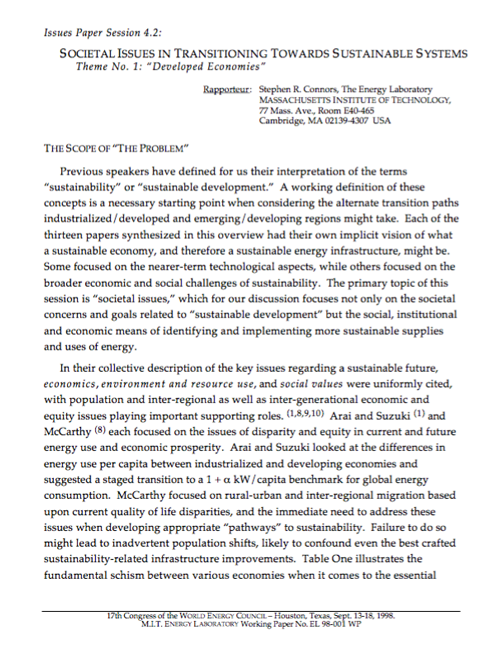
Abstract
The Scope of the “The Problem”
Previous speakers have defined for us their interpretation of the terms “sustainability” or “sustainable development.” A working definition of these concepts is a necessary starting point when considering the alternate transition paths industrialized/developed and emerging/developing regions might take. Each of the thirteen papers synthesized in this overview had their own implicit vision of what a sustainable economy, and therefore a sustainable energy infrastructure, might be. Some focused on the nearer-term technological aspects, while others focused on the broader economic and social challenges of sustainability. The primary topic of this session is “societal issues,” which for our discussion focuses not only on the societal concerns and goals related to “sustainable development” but the social, institutional and economic means of identifying and implementing more sustainable supplies and uses of energy.
In their collective description of the key issues regarding a sustainable future, economics, environment and resource use, and social values were uniformly cited, with population and inter-regional as well as inter-generational economic and equity issues playing important supporting roles. Arai and Suzuki and McCarthy each focused on the issues of disparity and equity in current and future energy use and economic prosperity. Arai and Suzuki looked at the differences in energy use per capita between industrialized and developing economies and suggested a staged transition to a 1 + α kW/capita benchmark for global energy consumption. McCarthy focused on rural-urban and inter-regional migration based upon current quality of life disparities, and the immediate need to address these issues when developing appropriate “pathways” to sustainability. Failure to do so might lead to inadvertent population shifts, likely to confound even the best crafted sustainability-related infrastructure improvements. Table One illustrates the fundamental schism between various economies when it comes to the essential infrastructures–water, food, energy, mobility, that rural and urban communities offer their citizenry. In this highly generalized representation, where neighboring regions have widely different standards of living, migration, if not political instability, is likely to occur. These disparities cannot be overlooked.